Profiling the Typical Training Load of a Law Enforcement Recruit Class
Abstract
1. Introduction
2. Materials and Methods
2.1. Subjects
2.2. Procedures
2.2.1. GPS and Desktop Analysis
2.2.2. Calculation of ACWR
2.2.3. Physical Training Modalities
2.3. Statistical Analysis
3. Results
3.1. Distance Covered
3.2. Acute:Chronic Workload Ratios
3.3. Class, Skills Training, and Physical Training
4. Discussion
5. Conclusions
Supplementary Materials
Author Contributions
Funding
Institutional Review Board Statement
Informed Consent Statement
Data Availability Statement
Acknowledgments
Conflicts of Interest
References
- Dawes, J.; Orr, R.; Flores, R.; Lockie, R.; Kornhauser, C.; Holmes, R. A physical fitness profile of state highway patrol officers by gender and age. Ann. Occup. Environ. Med. 2017, 29, 16. [Google Scholar] [CrossRef] [PubMed]
- Orr, R.; Hinton, B.; Wilson, A.; Pope, R.; Dawes, J. Investigating the Routine Dispatch Tasks Performed by Police Officers. Safety 2020, 6, 54. [Google Scholar] [CrossRef]
- Orr, R.; Pope, R.; Peterson, S.; Hinton, B.; Stierli, M. Leg power as an indicator of risk of injury or illness in police recruits. Int. J. Environ. Res. Public Health 2016, 13, 237. [Google Scholar] [CrossRef] [PubMed]
- Baran, K.; Dulla, J.; Orr, R.; Dawes, J.; Pope, R. Duty loads carried by LA Sheriff’s Department deputies. J. Aust. Strength Cond. 2018, 26, 34–38. [Google Scholar] [CrossRef]
- Tomes, C.; Orr, R.; Pope, R. The impact of body armor on physical performance of law enforcement personnel: A systematic review. Ann. Occup. Environ. Med. 2017, 29, 14–15. [Google Scholar] [CrossRef]
- Lyons, K.; Radburn, C.; Orr, R.; Pope, R. A profile of injuries sustained by Law Enforcement Officers: A Critical Review. Int. J. Environ. Res. Public Health 2017, 14, 142. [Google Scholar] [CrossRef]
- Yang, L.; Branscum, A.; Smit, E.; Dreher, D.; Howard, K.; Kincl, L. Work-related injuries and illnesses and their association with hour of work: Analysis of the Oregon construction industry in the US using workers’ compensation accepted disabling claims, 2007–2013. J. Occup. Health 2020, 62, e12118. [Google Scholar] [CrossRef]
- Nindl, B.; Williams, T.; Deuster, P.; Butler, N.; Jones, B. Strategies for optimizing military physical readiness and preventing musculoskeletal injuries in the 21st century. US Army Med. Dep. J. 2013, 5–23. [Google Scholar]
- Fuller, C.M. New South Wales Police Force Annual Report 2018–2019; New South Wales Police Force: Parramatta, Australia, 2019; pp. 1–120. [Google Scholar]
- Folkard, S.; Tucker, P. Shift work, safety and productivity. Occup. Med. 2003, 53, 95–101. [Google Scholar] [CrossRef]
- Orr, R.; Pope, R.; Stierli, M.; Hinton, B. A functional movement screen profile of an Australian state police force: A retrospective cohort study. BMC Musculoskelet. Disord. 2016, 17, 296. [Google Scholar] [CrossRef]
- Lockie, R.; Dulla, J.; Orr, R.; Dawes, J. Importance of Ability-Based Training for Law Enforcement Recruits. Strength Cond. J. 2021, 43, 80–90. [Google Scholar] [CrossRef]
- Knapik, J.; Sharp, M.; Canham-Chervak, M.; Hauret, K.; Patton, J.; Jones, B. Risk factors for training-related injuries among men and women in basic combat training. Med. Sci. Sport. Exerc. 2001, 33, 946. [Google Scholar] [CrossRef] [PubMed]
- Canetti, E.; Orr, R.; Schram, B.; Dawes, J.; Lockie, R.; Holmes, R.; Kornhauser, C. Aerobic conditioning is important, but anaerobic conditioning is crucial for police occupational task performance. In Proceedings of the TRANSFORM 2019 Physiotherapy Conference, Adelaide, SA, Australia, 17–18 October 2019. [Google Scholar]
- Lockie, R.; Dawes, J.; Balfany, K.; Gonzales, C.; Beitzel, M.; Dulla, J.; Orr, R. Physical Fitness Characteristics That Relate to Work Sample Test Battery Performance in Law Enforcement Recruits. Int. J. Environ. Res. Public Health 2018, 15, 2477. [Google Scholar] [CrossRef] [PubMed]
- Lockie, R.; Balfany, K.; Bloodgood, A.; Moreno, M.; Cesario, K.; Dulla, J.; Dawes, J.; Orr, R. The Influence of Physical Fitness on Reasons for Academy Separation in Law Enforcement Recruits. Int. J. Environ. Res. Public Health 2019, 16, 372. [Google Scholar] [CrossRef]
- Sorensen, L.; Smolander, J.; Louhevaara, V.; Korhonen, O.; Oja, P. Physical Activity, Fitness and Body Composition of Finnish Police Officers: A 15-year Follow-up Study. Occup. Med. 2000, 50, 3–10. [Google Scholar] [CrossRef]
- Crowley, S.; Wilkinson, L.; Wigfall, L.; Reynolds, A.; Muraca, S.; Glover, S.; Wooten, N.; Sui, X.; Beets, M.; Durstine, J.; et al. Physical fitness and depressive symptoms during army basic combat training. Med. Sci. Sport. Exerc. 2015, 47, 151–158. [Google Scholar] [CrossRef]
- Dawes, J.; Holmes, R.; Kornhauser, C. Boots on the Ground: Realizing Physical Potential while Combatting Reality. In Tactical Strength and Conditioning Report; NSCA: Colorado Springs, CO, USA, 2017. [Google Scholar]
- Gabbett, T. The training-injury prevention paradox: Should athletes be training smarter and harder? Br. J. Sport. Med. 2016, 50, 273–280. [Google Scholar] [CrossRef] [PubMed]
- Soligard, T.; Schwellnus, M.; Alonso, J.; Bahr, R.; Clarsen, B.; Dijkstra, H.; Gabbett, T.; Gleeson, M.; Hägglund, M.; Hutchinson, M.; et al. How much is too much? (Part 1) International Olympic Committee consensus statement on load in sport and risk of injury. Br. J. Sport. Med. 2016, 50, 1030–1041. [Google Scholar] [CrossRef]
- Colby, M.; Dawson, B.; Heasman, J.; Rogalski, B.; Gabbett, T. Accelerometer and GPS-derived running loads and injury risk in elite Australian footballers. J. Strength Cond. Res. 2014, 28, 2244–2252. [Google Scholar] [CrossRef]
- Piggott, B. The Relationship between Training Load and Incidence of Injury and Illness over a Pre-season at an Australian Football League Club; Edith Cowan University: Joondalup, Australia, 2008. [Google Scholar]
- Hulin, B.; Gabbett, T.; Blanch, P.; Chapman, P.; Bailey, D.; Orchard, J. Spikes in acute workload are associated with increased injury risk in elite cricket fast bowlers. Br. J. Sport. Med. 2014, 48, 708–712. [Google Scholar] [CrossRef]
- Hulin, B.; Gabbett, T.; Lawson, D.; Caputi, P.; Sampson, J. The acute: Chronic workload ratio predicts injury: High chronic workload may decrease injury risk in elite rugby league players. Br. J. Sport. Med. 2015, 50, 231–236. [Google Scholar] [CrossRef] [PubMed]
- Hulin, B.; Gabbett, T.; Caputi, P.; Lawson, D.; Sampson, J. Low chronic workload and the acute:chronic workload ratio are more predictive of injury than between-match recovery time: A two-season prospective cohort study in elite rugby league players. Br. J. Sport. Med. 2016, 50, 1008–1012. [Google Scholar] [CrossRef]
- Murray, N.; Gabbett, T.; Townshend, A.; Blanch, P. Calculating acute: Chronic workload ratios using exponentially weighted moving averages provides a more sensitive indicator of injury likelihood than rolling averages. Br. J. Sport. Med. 2017, 51, 749–754. [Google Scholar] [CrossRef] [PubMed]
- Impellizzeri, F.; Tenan, M.; Kempton, T.; Novak, A.; Coutts, A. Acute:Chronic Workload Ratio: Conceptual Issues and Fundamental Pitfalls. Int. J. Sport. Physiol. Perform. 2020, 15, 907–913. [Google Scholar] [CrossRef] [PubMed]
- Lolli, L.; Batterham, A.; Hawkins, R.; Kelly, D.; Strudwick, A.; Thorpe, R.; Gregson, W.; Atkinson, G. Mathematical coupling causes spurious correlation within the conventional acute-to-chronic workload ratio calculations. Br. J. Sport. Med. 2017, 53, 921–922. [Google Scholar] [CrossRef] [PubMed]
- Orr, R.; Schram, B.; Irving, S.; Pope, N.; Pope, R. Measuring Occupational Exposures to Osteoarthritis in the Lower Limb in Australian Defence Force Job Categories; Department of Veterans’ Affairs: Brisbane, Australia, 2020; p. 247. [Google Scholar]
- Huggins, R.; Giersch, G.; Belval, L.; Benjamin, C.; Curtis, R.; Sekiguchi, Y.; Peltonen, J.; Casa, D. The Validity and Reliability of Global Positioning System Units for Measuring Distance and Velocity During Linear and Team Sport Simulated Movements. J. Strength Cond. Res. 2020, 34, 3070–3077. [Google Scholar] [CrossRef] [PubMed]
- Williams, S.; West, S.; Cross, M.; Stokes, K. Better way to determine the acute:chronic workload ratio? Br. J. Sport. Med. 2017, 51, 209–210. [Google Scholar] [CrossRef]
- Maupin, D.; Schram, B.; Canetti, E.; Dawes, J.; Lockie, R.; Orr, R. Developing the Fitness of Law Enforcement Recruits during Academy Training. Sustainability 2020, 12, 7944. [Google Scholar] [CrossRef]
- Giavarina, D. Understanding Bland Altman analysis. Biochem. Med. 2015, 25, 141–151. [Google Scholar] [CrossRef]
- Kalra, A. Decoding the Bland–Altman plot: Basic review. J. Pract. Cardiovasc. Sci. 2017, 3, 36. [Google Scholar] [CrossRef]
- Field, A.; Miles, J.; Field, Z. Compaing several means: ANOVA (GLM 1). In Discovering Statistics Using R; Sage Publications: Thousand Oaks, CA, USA, 2012; pp. 398–461. [Google Scholar]
- Issurin, V. New Horizons for the Methodology and Physiology of Training Periodization. Sport. Med. 2010, 40, 189–206. [Google Scholar] [CrossRef] [PubMed]
- Moreno, M.R.; Cesario, K.A.; Bloodgood, A.M.; Dulla, J.M.; Lockie, R.G. Heart rate response of a custody assistant class to circuit training during the academy period. In Proceedings of the Southwest American College of Sports Medicine’s 37th Annual Meeting, Long Beach, CA, USA, 20 October 2017. [Google Scholar]
- O’Leary, T.; Saunders, S.; McGuire, S.; Venables, M.; Izard, R. Sex Differences in Training Loads during British Army Basic Training. Med. Sci. Sport. Exerc. 2018, 50, 2565–2574. [Google Scholar] [CrossRef] [PubMed]
- Knapik, J.; Grier, T.; Spiess, A.; Swedler, D.; Hauret, K.; Graham, B.; Yoder, J.; Jones, B. Injury rates and injury risk factors among Federal Bureau of Investigation new agent trainees. BMC Public Health 2011, 11, 920. [Google Scholar] [CrossRef]
- Maupin, D.J.; Canetti, E.F.D.; Schram, B.; Lockie, R.G.; Dawes, J.J.; Dulla, J.M.; Orr, R.M. Profiling the injuries of law enforcement recruits during academy training: A retrospective cohort study. BMC Sport. Sci. Med. Rehabil. 2022, 14, 136. [Google Scholar] [CrossRef] [PubMed]
- Booth, C.; Probert, B.; Forbes-Ewan, C.; Coad, R. Australian Army Recruits in Training Display Symptoms of Overtraining. Mil. Med. 2006, 171, 1059–1064. [Google Scholar] [CrossRef]
- Dos Santos Bunn, P.; de Oliveira Meireles, F.; de Souza Sodré, R.; Rodrigues, A.I.; da Silva, E.B. Risk factors for musculoskeletal injuries in military personnel: A systematic review with meta-analysis. Int. Arch. Occup. Environ. Health 2021, 94, 1173–1189. [Google Scholar] [CrossRef]
- Colby, M.; Dawson, B.; Peeling, P.; Heasman, J.; Rogalski, B.; Drew, M.; Stares, J. Improvement of Prediction of Noncontact Injury in Elite Australian Footballers With Repeated Exposure to Established High-Risk Workload Scenarios. Int. J. Sport. Physiol. Perform. 2018, 13, 1130–1135. [Google Scholar] [CrossRef]
- Aughey, R. Widening margin in activity profile between elite and sub-elite Australian football: A case study. J. Sci. Med. Sport 2012, 16, 382–386. [Google Scholar] [CrossRef]
- Gastin, P.; Huntsman, E.; Meyer, D.; Cook, J. Injury risk factors in elite Australian football. J. Sci. Med. Sport 2013, 16, e57. [Google Scholar] [CrossRef]
- Trank, T.; Ryman, D.; Minagawa, R.; Trone, D.; Shaffer, R. Running mileage, movement mileage, and fitness in male US Navy recruits. Med. Sci. Sport. Exerc. 2001, 33, 1033–1038. [Google Scholar] [CrossRef]
- Cesario, K.A.; Moreno, M.R.; Bloodgood, A.M.; Dulla, J.M.; Lockie, R.G. Heart rate response of a custody assistant class to a formation run during academy training. In Proceedings of the Southwest American College of Sports Medicine’s 37th Annual Meeting, Long Beach, CA, USA, 20 October 2017. [Google Scholar]
- Kalkhoven, J.; Watsford, M.; Impellizzeri, F. A conceptual model and detailed framework for stress-related, strain-related, and overuse athletic injury. J. Sci. Med. Sport 2020, 23, 726–734. [Google Scholar] [CrossRef] [PubMed]
- Hauschild, V.; DeGroot, D.; Hall, S.; Grier, T.; Deaver, K.; Hauret, K.; Jones, B. Fitness tests and occupational tasks of military interest: A systematic review of correlations. Occup. Environ. Med. 2017, 74, 144–153. [Google Scholar] [CrossRef] [PubMed]
- Murawska-Cialowicz, E.; Wolanski, P.; Zuwala-Jagiello, J.; Feito, Y.; Petr, M.; Kokstejn, J.; Stastny, P.; Golinski, D. Effect of HIIT with Tabata Protocol on Serum Irisin, Physical Performance, and Body Composition in Men. Int. J. Environ. Res. Public Health 2020, 17, 3589. [Google Scholar] [CrossRef] [PubMed]
- Carey, D.L.; Crossley, K.M.; Whiteley, R.O.D.; Mosler, A.; Ong, K.-L.; Crow, J.; Morris, M.E. Modeling Training Loads and Injuries: The Dangers of Discretization. Med. Sci. Sport. Exerc. 2018, 50, 2267–2276. [Google Scholar] [CrossRef]
- Impellizzeri, F.M.; Woodcock, S.; Coutts, A.J.; Fanchini, M.; McCall, A.; Vigotsky, A.D. What Role Do Chronic Workloads Play in the Acute to Chronic Workload Ratio? Time to Dismiss ACWR and Its Underlying Theory. Sport. Med. 2020, 51, 581–592. [Google Scholar] [CrossRef]
- Canetti, E.; Orr, R.; Schram, B.; Brown, W.; Dawes, J. Fitness assessments as predictors of performance in police occupational tasks. In Proceedings of the TRANSFORM 2019 Physiotherapy Conference, Adelaide, SA, Australia, 17–19 October 2019. [Google Scholar]
- Moreno, M.; Cesario, K.; Bloodgood, A.; Lockie, R. Circuit strength training with ability-based modifications for law enforcement recruits. Tactical Strength Cond. Rep. 2018, 51, 26–33. [Google Scholar]
- Alvar, B.; Sell, K.; Deuster, P. NSCA’s Essentials of Tactical Strength and Conditioning; Human Kinetics: Champaign, IL, USA, 2017. [Google Scholar]


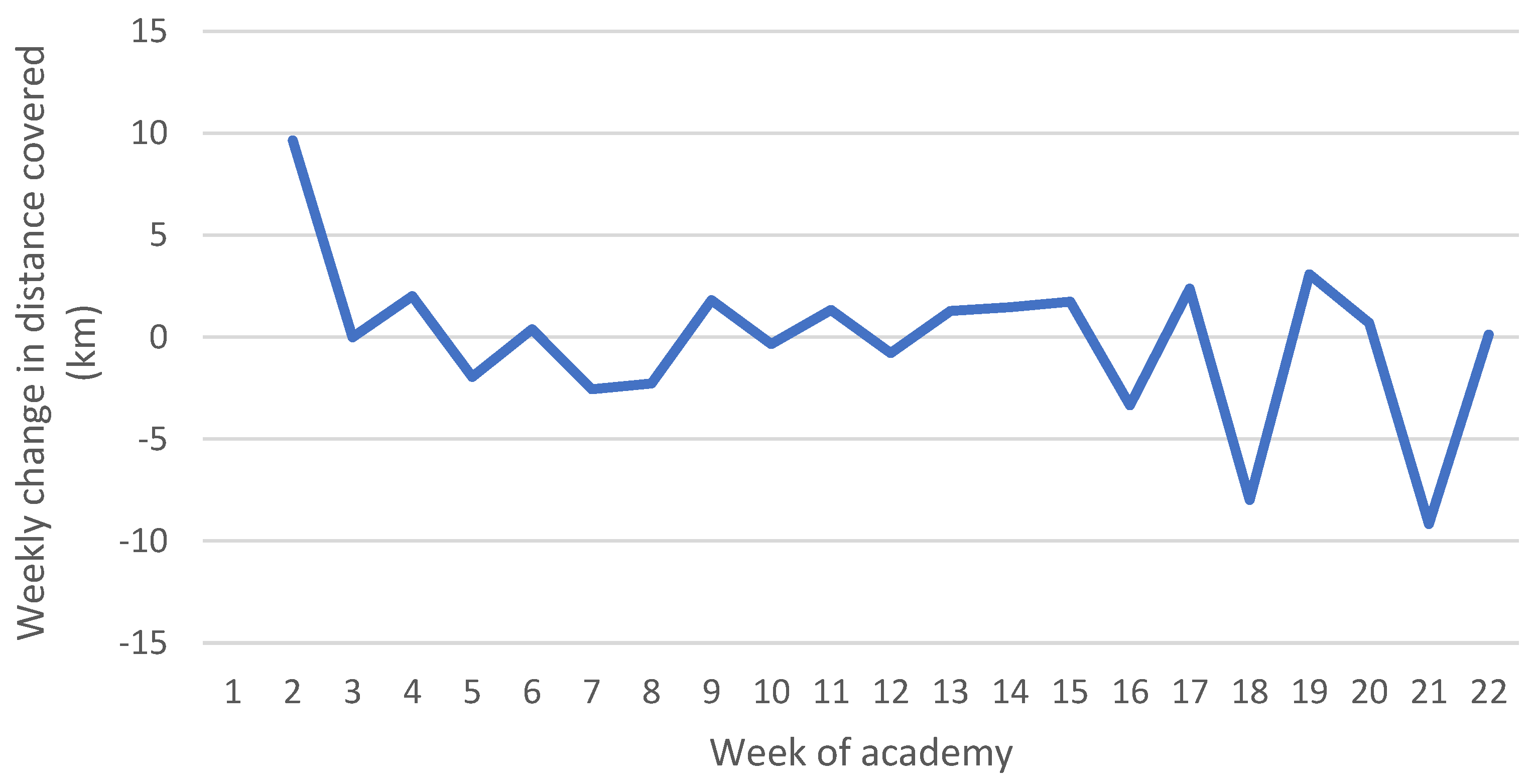
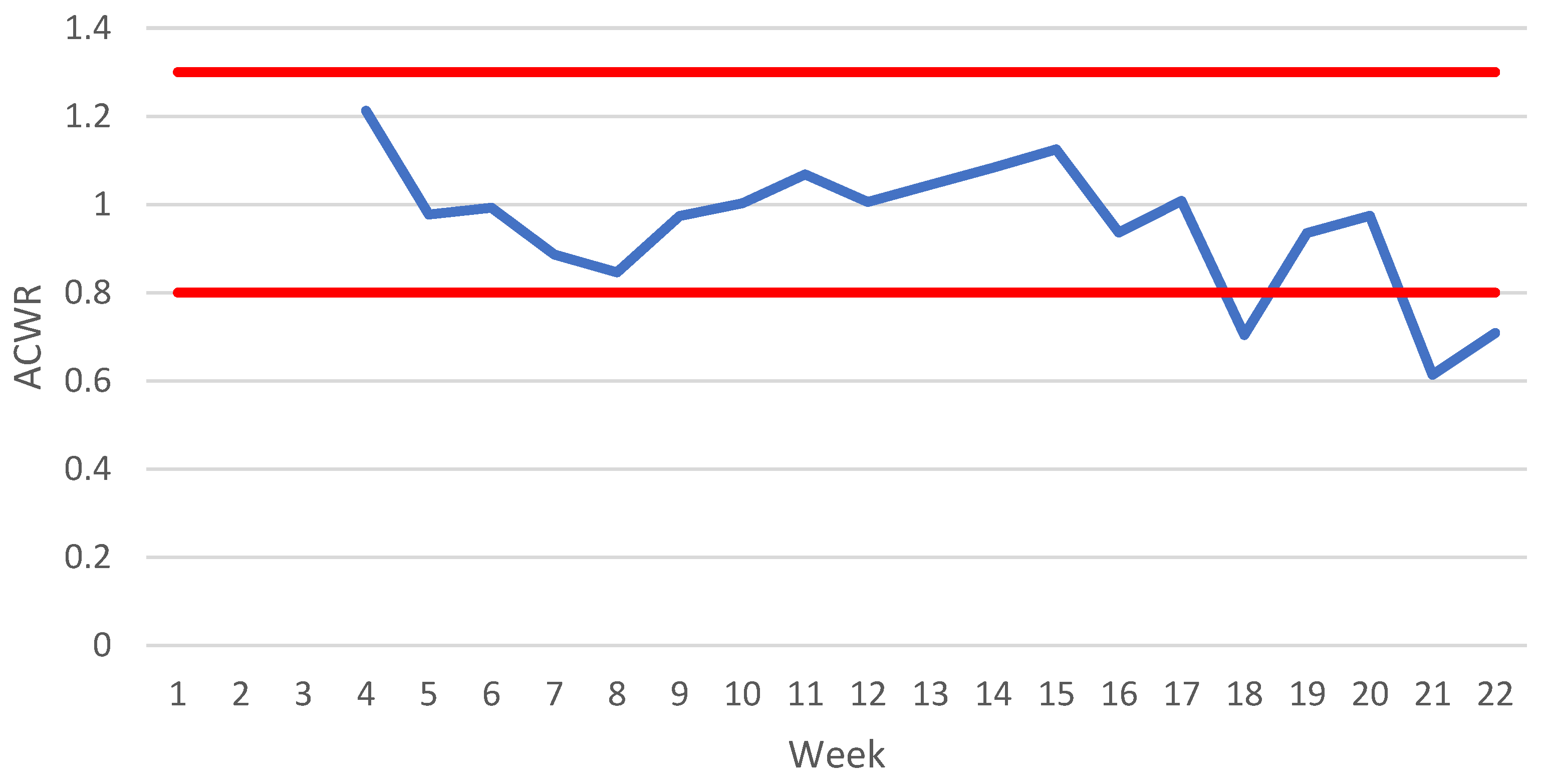
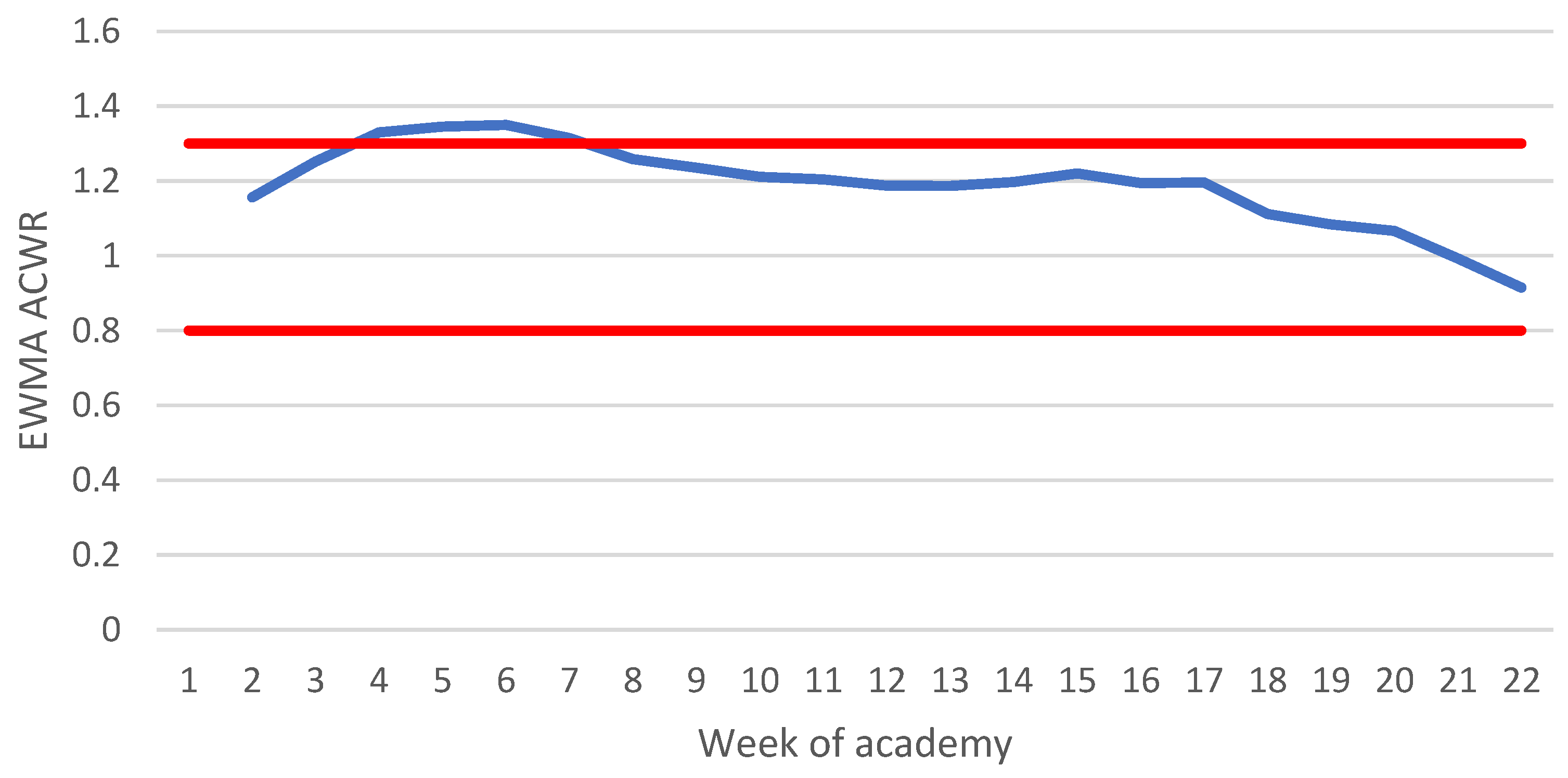
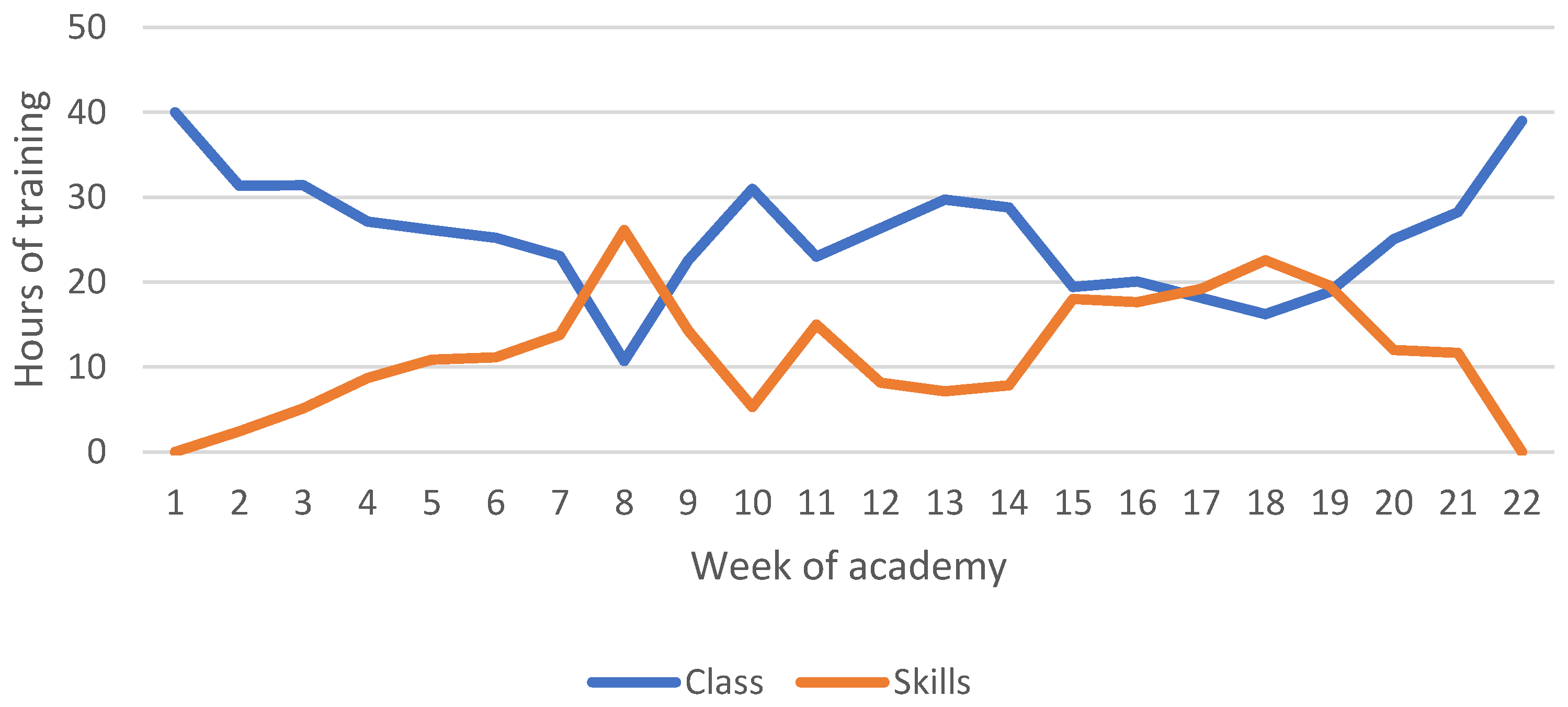
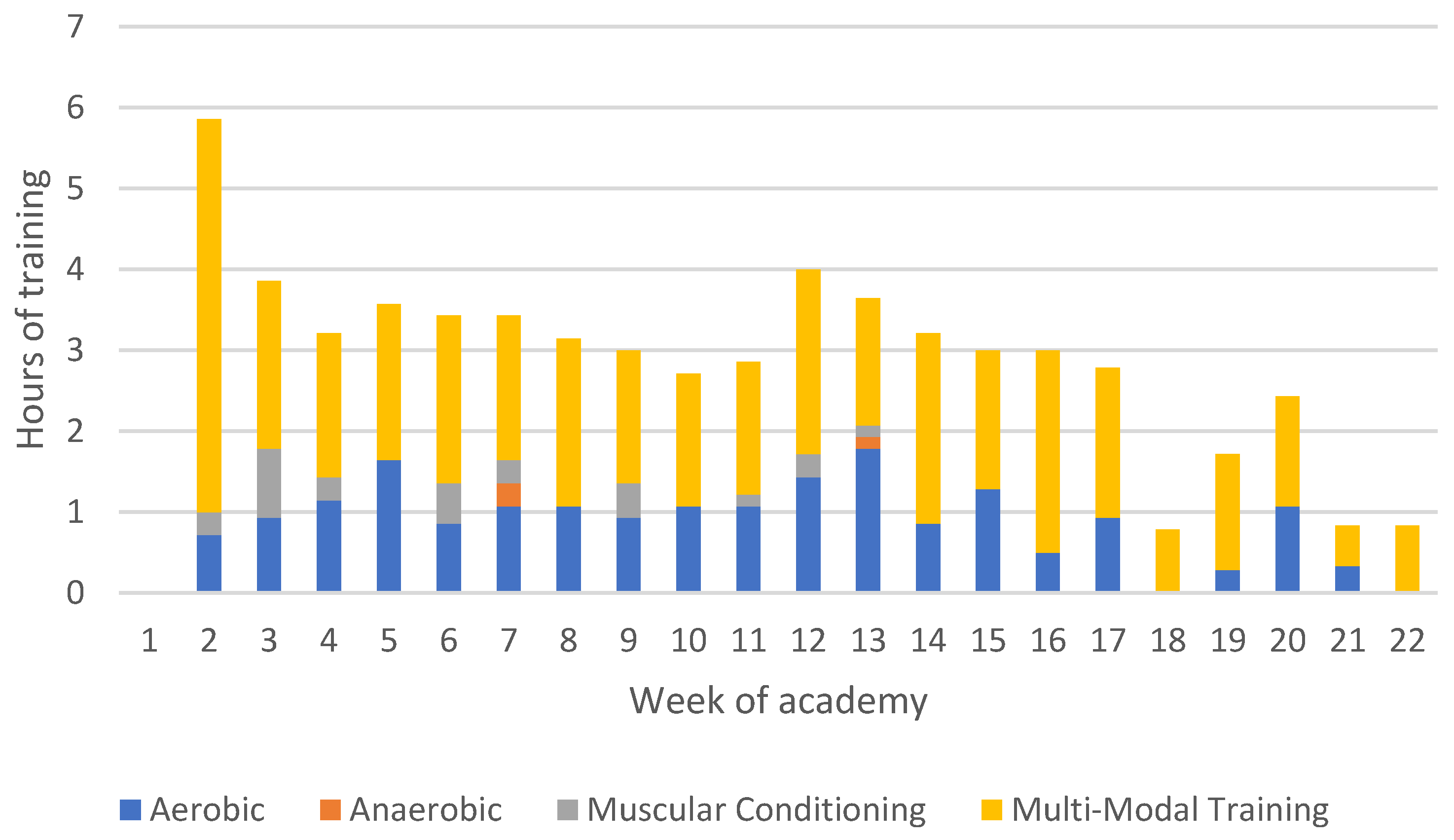
| Training Modality | Definition |
|---|---|
| Anaerobic | High-intensity, intermittent bouts of training |
| Aerobic | Low-intensity, long training |
| Muscular conditioning | Training periods focused on weightlifting and other activities to increase muscular strength |
| Multi-modal | Training that encompasses a combination of anaerobic, aerobic, and muscular conditioning |
| Skills training | Training sessions focused on occupational skills such as weapons handling or evasive driving |
| Classroom | Time spent receiving a lecture |
| Class Number and Duration | Average Distance per Week (km) | # of SD from Mean |
|---|---|---|
| Class 1—22 weeks | 17.99 | 0.45 |
| Class 2—22 weeks | 17.12 | −0.68 |
| Class 3—22 weeks | 18.72 | 1.4 |
| Class 4—22 weeks | 18.44 | 1.03 |
| Class 5—22 weeks | 16.64 | −1.30 |
| Class 6—22 weeks | 17.56 | −0.11 |
| Class 7—20 weeks | 17.04 | −0.79 |
| Total mean (SD) | 17.64 (0.77) |
Publisher’s Note: MDPI stays neutral with regard to jurisdictional claims in published maps and institutional affiliations. |
© 2022 by the authors. Licensee MDPI, Basel, Switzerland. This article is an open access article distributed under the terms and conditions of the Creative Commons Attribution (CC BY) license (https://creativecommons.org/licenses/by/4.0/).
Share and Cite
Maupin, D.; Schram, B.; Canetti, E.F.D.; Dulla, J.M.; Dawes, J.J.; Lockie, R.G.; Orr, R.M. Profiling the Typical Training Load of a Law Enforcement Recruit Class. Int. J. Environ. Res. Public Health 2022, 19, 13457. https://doi.org/10.3390/ijerph192013457
Maupin D, Schram B, Canetti EFD, Dulla JM, Dawes JJ, Lockie RG, Orr RM. Profiling the Typical Training Load of a Law Enforcement Recruit Class. International Journal of Environmental Research and Public Health. 2022; 19(20):13457. https://doi.org/10.3390/ijerph192013457
Chicago/Turabian StyleMaupin, Danny, Ben Schram, Elisa F. D. Canetti, Joseph M. Dulla, J. Jay Dawes, Robert G. Lockie, and Robin M. Orr. 2022. "Profiling the Typical Training Load of a Law Enforcement Recruit Class" International Journal of Environmental Research and Public Health 19, no. 20: 13457. https://doi.org/10.3390/ijerph192013457
APA StyleMaupin, D., Schram, B., Canetti, E. F. D., Dulla, J. M., Dawes, J. J., Lockie, R. G., & Orr, R. M. (2022). Profiling the Typical Training Load of a Law Enforcement Recruit Class. International Journal of Environmental Research and Public Health, 19(20), 13457. https://doi.org/10.3390/ijerph192013457










